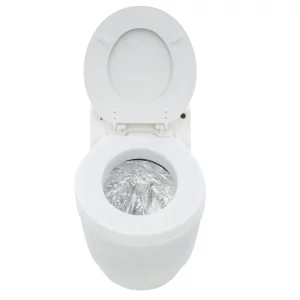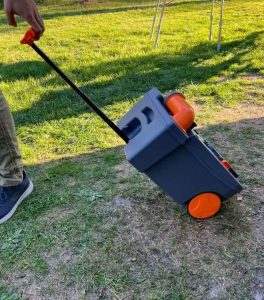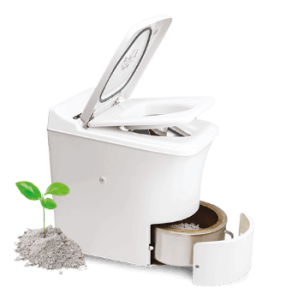All About Tiny House Toilets
Check out the options
 Talking about the details of pooping and peeing can be a little bit uncomfortable, but come on. We all do it every day of our lives (usually), so there’s no shame in it and it can actually be a bit liberating to just come out and talk about it like any other topic. So, let’s dig into the question: what are some of the tried and true ways of managing pee and poo when you live in a tiny home?
Talking about the details of pooping and peeing can be a little bit uncomfortable, but come on. We all do it every day of our lives (usually), so there’s no shame in it and it can actually be a bit liberating to just come out and talk about it like any other topic. So, let’s dig into the question: what are some of the tried and true ways of managing pee and poo when you live in a tiny home?
Composting Toilet
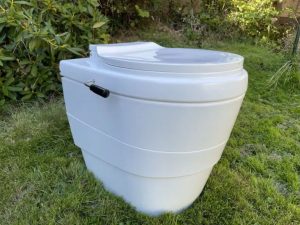
The Thinktank composting toilet
This can be any container you can sit on to do your business. A box or a 5 gallon bucket are great options. Once you go, you add some kind of cover, or “bulking,” material to absorb the smell and aid in the composting process. This need not be high tech. Just some sawdust or forest duff will work. But you can also use commercial products like Sun-Mar Compost. The key with these materials is that they must be high in carbon in order to help with the composting. If you are using a permanent seat of some sort, you will want to vent it to help keep things fresh.
That’s the basics, but most people won’t want to just use a bucket or a box. If you have a guest over and they have to “use the restroom” it might be nice to offer them something that looks like a toilet. But maybe not. I depends on your guest! Fortunately, there are more sophisticated versions of the composting toilet available commercially. Some of these separate the urine from the poo to make handling and composting easier and they also have a mixer to stir things up and mix in the bulking material. There are several advantages to separating urine and poo: the result smells much better if you keep them separate, and urine does not require composting. Some composting toilets have the option of diverting urine to a drain that can be directed to a French drain or a gravel pit.
It’s not enough to just have a composting toilet. You also need a plan for the actual composting. That’s right, the complete composting process doesn’t happen in the toilet–that would obviously take way too long and your toilet would fill up. Here is a description of the composting process for poo, from Composting Toilets:
You need two compost bins to compost human waste. Use one at a time. When the first bin is full, start using the second bin. When the second bin is full, the first one should be ready for the plants.
Add lime to the compost bin. This will drastically reduce the time it has to sit, before being safe to bury or spread on non-edible plants. Use roughly 3% lime to total waste volume – i.e. if you have a full 50 gallon drum of waste, use 1.5 gallons of lime. These numbers are very approximate. With lime added, the bin needs to sit undisturbed, without adding new material, for 120 days according to the BC Composting Toilets Guidelines. This should kill all pathogens. Without the lime, the time frame is much more uncertain, and varies from 6 months to 2 years, according to various sources.
Note that you should not use human manure to fertilize edible plants, even when it is fully composted. Some of the pathogens can get into the plants. So, you will want to burry it or use it on non-edible plants. Urine, however, is very safe and can be used to fertilize any plants straightaway.
Uses
Off Grid: Ideal
On Grid: Can work too
More information about composting toilets
- Thinktank Waterless Composting Toilets
- Sun-Mar Urine Diverting Toilets
- Nature’s Head
- Humanure, a book about composting human manure
Dry Flush Toilet or Container Based (CBS)
These go by several names, including container based (CBS) or cartridge toilets (this name is also used for cassette toilets, so confusing–see below). With a dry flush toilet, the waste is collected in a lining made of special material that is strong and waterproof. When you “flush,” the toilet wraps up the waste in the liner and stores the package in the bottom of the toilet. The final product is a clean, odorless package that can be be disposed of in the garbage. It’s basically like a baby diaper as far as the garbage dump is concerned, so there is no problem on that end. Dry Flush toilets are also available with urine diversion so that the containers only have poo in them.
Note that container based toilets are a popular application in developing word projects where sanitation infrastructure is lacking. However, those toilets are not typically available in the US market. Here in the US and Canada the Laveo Dry Flush is the only commercially available option.
One of the drawbacks of the Laveo Dry Flush is that the waste is not recycled. The container is not biodegradable and so it has to go to the dump.
More information about dry flush toilets
Cassette Toilet
This option is more for the RV or van life world, but it’s worth a mention. The cassette toilet functions just like a regular flush toilet and uses water for flushing. The waste (urine, poop, and water) is collected in a portable and reusable container underneath the toilet. When the container fills up, it can be removed in a safe and clean manner and the waste is dumped into a toilet, RV disposal site, or even a “porta potty.”
Cassette toilets are typically used in RV as an alternative to to the “black tank” collection method (the typical system used for RVs that has a larger tank). The cassettes in this system are about the size of a carry on suitcase and they even come with wheels and a handle. They are also designed to slide out of an exterior opening. That means that to use one in a tiny house you would have to design for it from the start or do some retrofitting. This could be a really good solution for a tiny house with access to a traditional bathroom. For example, a tiny house in a back yard. because you could just empty your cassette into the toilet every couple weeks and nothing more would be required.
A downside of Cassette toilets is that the cassette is small and because the toilet also uses water, it can fill up pretty quickly. That means that depending on how many people use it and how frequently, it has to be emptied every 2-5 days or so.
More information on Cassette Toilets
Incinerating Toilets
Incinerating toilets collect the waste in a paper liner. When you “flush,” the top compartment of the toilet opens up and the liner and waste fall into a lower chamber. This bottom chamber is the incinerator, which is heated by electricity, and over a period of 45 minutes to a couple hours (depending on the type of toilet and how much waste), everything is reduced to ash. This ash is completely safe and bacteria free so it can be dumped in the garbage or used as fertilizer.
Incinerating toilets need a lot of power–the are basically little ovens–and because of this they are not recommended for off-grid solar power applications. But if you are on the grid, this is a really convenient options, especially for anyone who is squeamish about handling waste. With this toilet, all you have to do is deal with ashes.
More info on incinerating toilets
Biogass
The biogas toilet is a variation on the composting toiled with a bonus: it produces cooking gas. The entire thing is set up from toilet all the way to the burner.
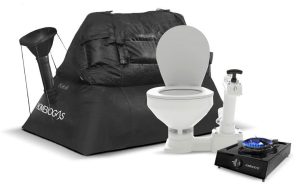
Biogas Toilet Kit
As you can see from the photo, the composting component is fairly large and also noticeable. It will be a conversation piece for sure. But one implication is that this is not a great option if you are going to be moving around. Biogas will work best as a permanent installation. Another bonus is that you can also toss other compostable items into the composting bladder. That’s what the big funnel is for.
Some things to keep in mind about the Biogass toilet. First, it does not work well in cold climates. The ideal temperature is above 68 degrees, but there are some things that can be done to deal with colder climates or with winter temperatures (see the website for more information about that). The other thing is that Biogas does produce waste as well. It’s not all gas. If you are just using it for composting, you can reuse that waste as compost for any plants. However, if you are using it for a toilet, you will have to find a way to get the waste into the sewer system, or into a sewer tank.
More information about the Biogas Toilet Kit
Flush Toilet
This guy needs no introduction. But it’s worth noting that many tiny homes use a regular flush toilet. In this case, it will have to be plumbed like any regular toilet and connected to the local sewer or to a drainfield.

